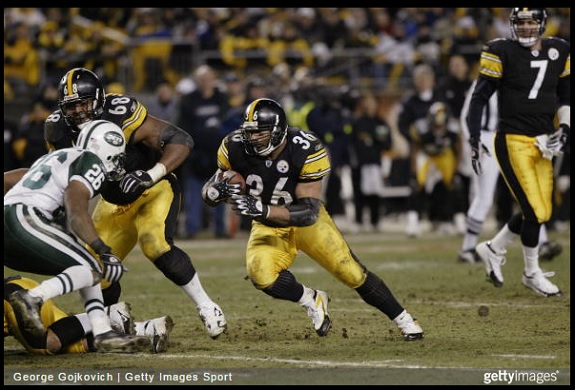Another series, a collaborative one, to take you through the remaining weeks of the offseason. Jon Ledyard and I will pick a side in choosing the greatest Pittsburgh Steelers at each position. Tell us who is right and who won the debate – those don’t have to be the same answer – in the comments.
We move to the running backs today. My selection is Franco Harris while Jon makes a case for Jerome Bettis.
JON:
The question of who the greatest running back in Steelers history is might be the most important one in this series, based largely on the fact that this city so eagerly finds its identity in the ground-and-pound run game that has become synonymous with Pittsburgh football. Times have certainly changed, and while the Steelers offensive attack may now be more passing-oriented than ever before, the run game will always be a much-appreciated aspect of football in this city.
Perhaps no player epitomized that heart-and-soul, get-off-the-tracks, bull-dozing style of football that Pittsburgh craves quite like Jerome Bettis did, from his first season in Pittsburgh to his final, Super Bowl-winning campaign in 2005. One of the most unique running backs ever to lace up cleats, Bettis’ hulking 5’11, 250-pound frame ran roughshod over defenders throughout his 10 years in the ‘Burgh, barreling his way into fans’ hearts with every powerful stride.
Make no mistake, Bettis’ game was far from sexy, and that is just how Pittsburgh liked it. On his way to rushing for well over 10,000 yards with the Black and Gold, Bettis’ toughness and physical style of play not only endeared him to a hard-nosed fan base, but also to his teammates and coaches. He may not have had the flash and athleticism that many of the big-name backs in today’s game possess, (heck, Bettis was literally overweight, even in his heyday) but he still found ways to get the job done. Six straight 1,000-yard rushing seasons were produced during his time in Pittsburgh, and even with the wheels falling off “The Bus” in his final seasons, Bettis gave Pittsburgh his all.
Who can forget Bettis plowing over the great Brian Urlacher on his way to the end zone in a crucial 21-9, Week 9 victory over the Chicago Bears in 2005? Despite standing at just 7-5 and coming off a three-game losing streak at the time, Pittsburgh would not lose again that year, thanks largely to Bettis’ two-touchdown, 105-yard effort in that turning point victory. The big back would go on to score in each of the team’s playoff games leading up to their Super Bowl matchup against the Seattle Seahawks. Even in Bettis’ final season, unquestionably the weakest statistical campaign of his career, his efforts were crucial to propelling Pittsburgh to yet another Super Bowl title.
Obviously Bettis’ career ended in storybook fashion, as the powerful rusher lifted the Lombardi Trophy in his hometown of Detroit that year for the first and only time throughout his NFL tenure. It was a hard-fought, churn-it-out Super Bowl win, the perfect kind of game for one of the all-time grinders to finish his career on.
Bettis wasn’t always the back Pittsburgh wanted while fans watched lithe and agile rushers like Curtis Martin and Marshall Faulk tear up for their respective franchises, but he may have been the one they needed. Bettis represented a style of football that this city has long identified themselves with: gritty, violent, and tough. While others like Franco Harris certainly have their place in Steelers lore based on longevity and production, there is something to be said for the way Bettis consistently ground his way into the history books and eventually the Hall of Fame. There have been many great backs in Steelers history, but none have matched the city’s mantra and personality on their way to elite production quite like The Bus did.
ALEX:
I love Steelers’ history. The old history. Before Chuck Noll. The era of lovable losers, dawdling around in relative obscurity with only few peaks and many, many valleys. I love it, for one reason, because it is so under-examined by the Steelers’ community.
There is a clear line drawn on when we start talking about when the Steelers began and when they really began. And it is all a result of Franco Harris’ Immaculate Reception.
The story has been told countless times and I won’t try to pretend I’m the best man to recount it, never witnessing it in person. But you and I know the impact it had on this franchise, this city. The ricochet of the pass, the fingertip catch, the dash to the end zone.
That’s what makes Harris so memorable. But it isn’t obviously what made him so great. Nearly 12,000 yards rushing with the Steelers. A 4.1 yards per carry. Both better numbers than The Bus. MVP of Super Bowl IX, rushing for 158 to give his team the first Lombardi Trophy in the franchise’s overdue history. Five postseason 100+ yard rushing performances to Bettis’ three, who never topped 105 yards in the playoffs.
Clearly, this is not a campaign against The Bus. I’m elated he’s finally in the Hall of Fame. But he isn’t quite on the level Harris was. By the end of Jerome’s career, he was a niche back, a short-yardage piece who was truly three yards and a cloud of dust. From 2002-2005, he averaged 3.5 yards per carry. Harris had a slightly better 3.8 YPC and was still the lead back in his final year with the Steelers, starting 16 games and running for over 1000 yards.
Ball don’t lie. And neither does the Hall of Fame voting bears that out. Harris retired in 1984 and got in six years later. Bettis took ten to get the call.
Bettis enhanced Pittsburgh’s winning culture. Harris created it.








